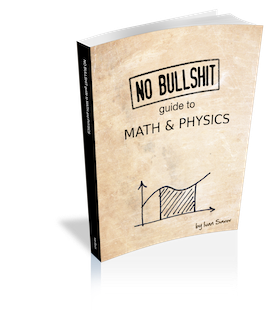The page you are reading is part of a draft (v2.0) of the "No bullshit guide to math and physics."
The text has since gone through many edits and is now available in print and electronic format. The current edition of the book is v4.0, which is a substantial improvement in terms of content and language (I hired a professional editor) from the draft version.
I'm leaving the old wiki content up for the time being, but I highly engourage you to check out the finished book. You can check out an extended preview here (PDF, 106 pages, 5MB).
Great outdoors
Vectors are directions. Directions are “recipes” for getting from point A to point B. Directions can be given in terms of street names and visual landmarks or with respect to a coordinate system.
While on vacation in BC, you want to visit a certain outdoor location which you friend has told you about. Your friend is not available to take you there himself, but he has sent you directions for how to get to the place from the bus stop:
Sup G. Go to bus stop number 345. Bring a compass. Walk 3km North then 4km East. U will find X there.
This text message is all that you need in order to find $X$.
Act 1: Directions
You get to the bus station. A beautiful field spreads in front of you. The bus stop at the top of a small hill so from up here you can see the whole valley. The field is full of very tall crops which prevent anyone walking in them to see very far; good thing you have a compass. You align the compass needle to the marks on the glass so that the red arrow points North. You walk 3km Northward and then you turn to the right (East) and walk another 4km. You get to X.
OK, back to vectors. In this case, the directions recipe can be written as a directions vector $\vec{d}$ as follows: \[ \vec{d} = 3\textrm{km}\: \hat{N} + 4\textrm{km}\: \hat{E}, \] which is the mathematical expression that corresponds to the directions “walk 3km North then 4km East.” Here $\hat{N}$ is a direction and the number in front of the direction tells me the distance that I should walk in that direction.
Act 2: Equivalent directions
Later on in your vacation, you decide to return to the location. When you arrive at the bus stop, you see that there is a slight problem. From your position you can see that, just a kilometre north of you, there is a group of armed and threatening looking men waiting in ambush on what has now become a trail in the crops. Clearly the word has spread about X and several people have come here promoting too much attention to the location.
Well, technically speaking, there is no problem with X. The problem is on the route that starts off North and goes through the ambush. Could you find an alternate route to get to X?
"Use math, Luke! Use math!"
For numbers we have $a+b=b+a$, maybe we can do the same thing with vectors: \[ \vec{d} = 3\textrm{km}\: \hat{N} + 4\textrm{km}\: \hat{E} = 4\textrm{km}\: \hat{E} + 3\textrm{km}\: \hat{N}. \] Yes you can. You walk the 4[km] East first then 3[km] North and get to X again. This equivalent set of directions completely avoids the ambush.
Act 3: Efficiency
It takes $7$[km] of walking to get from the bus stop to X and another $7$[km] to get back. Thus, it takes a total of $14$[km] walking every time you want to go to X. Could you find a shorter route? What is the shortest route to the destination? If you take the diagonal it will certainly be quicker. Using Pythagoras theorem you can even calculate how long the diagonal is when the sides are $4$ and $3$ in length. The diagonal has length $\sqrt{4^2 + 3^2} = \sqrt{16 + 9} = \sqrt{25} = 5$. The direction you need to walk in at $53^\circ$ (on a compass degrees are measured from the $\hat{N}$ direction, starting towards East). The direct route is $5$ km long which means that you are saving a whole 2 km of walking in each direction.
But perhaps seeking efficiency is not always necessary! You could take a longer path and give yourself time to enjoy the great outdoors.
Discussion
Vectors are directions for getting from one point to another point. For directions on maps, we use the four cardinal directions: $\hat{N}$, $\hat{S}$, $\hat{E}$, $\hat{W}$, but in math we will use just two of them: $\hat{E}\equiv\hat{x}$ and $\hat{N}\equiv\hat{y}$, since they fit nicely with the usual way of drawing the cartesian plane. We don't need an $\hat{S}$ direction because we can represent downward distances as negative distances in the $\hat{N}$ direction. Similarly, $\hat{W}$ is just negative $\hat{E}$.
From now on, when we talk about vectors they will always be represented in the standard coordinate system $\hat{x}$ and $\hat{y}$ so we can use a bracket notation: \[ (v_x, v_y) \equiv v_x \: \hat{x} \ + \ v_y\:\hat{y}. \]
The bracket notation is very compact, which is good if you are going to be doing a lot of calculations with vectors. Instead of writing down explicitly the basis elements (the directions), you simply assume that the first number in the bracket is the $\hat{x}$ distance and the second number is the $\hat{y}$ distance.
